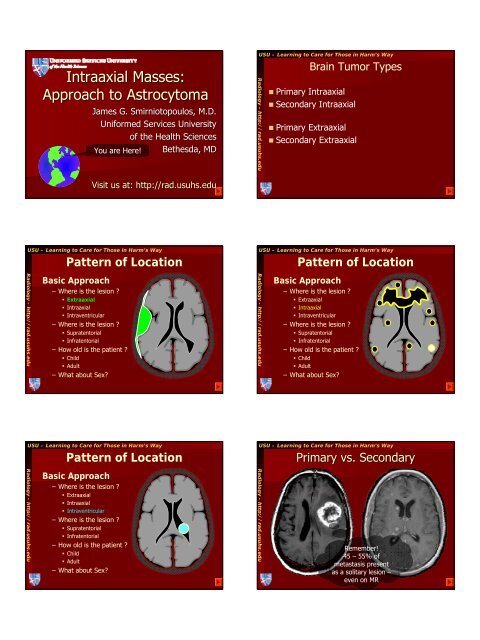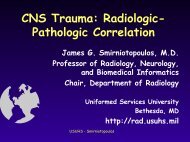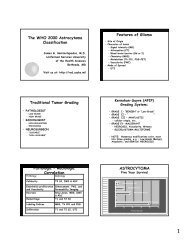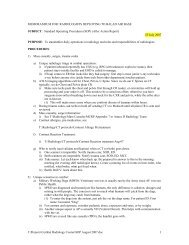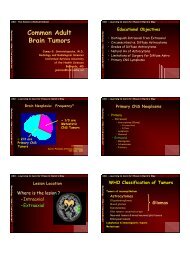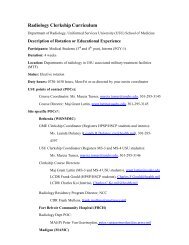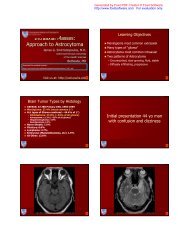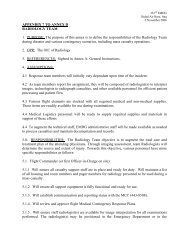the who 2000 tumor classification - Radiology - Uniformed Services ...
the who 2000 tumor classification - Radiology - Uniformed Services ...
the who 2000 tumor classification - Radiology - Uniformed Services ...
- No tags were found...
Create successful ePaper yourself
Turn your PDF publications into a flip-book with our unique Google optimized e-Paper software.
Intraaxial Masses:Approach to Astrocytoma*James G. Smirniotopoulos, M.D.<strong>Uniformed</strong> <strong>Services</strong> Universityof <strong>the</strong> Health SciencesYou are Here! Be<strong>the</strong>sda, MDUSU – Learning to Care for Those in Harm’s WayBrain Tumor Types<strong>Radiology</strong> - http://rad.usuhs.edu• Primary Intraaxial• Secondary Intraaxial• Primary Extraaxial• Secondary ExtraaxialVisit us at: http://rad.usuhs.eduUSU – Learning to Care for Those in Harm’s WayPattern of Location<strong>Radiology</strong> - http://rad.usuhs.eduBasic Approach– Where is <strong>the</strong> lesion ?• Extraaxial• Intraaxial• Intraventricular– Where is <strong>the</strong> lesion ?• Supratentorial• Infratentorial– How old is <strong>the</strong> patient ?• Child• Adult– What about Sex?USU – Learning to Care for Those in Harm’s WayPattern of Location<strong>Radiology</strong> - http://rad.usuhs.eduBasic Approach– Where is <strong>the</strong> lesion ?• Extraaxial• Intraaxial• Intraventricular– Where is <strong>the</strong> lesion ?• Supratentorial• Infratentorial– How old is <strong>the</strong> patient ?• Child• Adult– What about Sex?USU – Learning to Care for Those in Harm’s Way<strong>Radiology</strong> - http://rad.usuhs.eduPattern of LocationBasic Approach– Where is <strong>the</strong> lesion ?• Extraaxial• Intraaxial• Intraventricular– Where is <strong>the</strong> lesion ?• Supratentorial• Infratentorial– How old is <strong>the</strong> patient ?• Child• Adult– What about Sex?USU – Learning to Care for Those in Harm’s WayPrimary vs. Secondary<strong>Radiology</strong> - http://rad.usuhs.eduRemember!45 – 55% ofmetastasis presentas a solitary lesion –even on MR
USU – Learning to Care for Those in Harm’s Way<strong>Radiology</strong> - http://rad.usuhs.eduPRIMARY NEOPLASMSNeuroectodermal• Neuroectoderm– Embryologic Neural Tube– “Neuroepi<strong>the</strong>lial”• Broad Categories– Glial Tumors (Gliomas(Gliomas)– Embryonal/Immature (P.N.E.T.(P.N.E.T.’s)– Neuronal (Neurocytoma)– Mixed (Ganglioglioma)USU – Learning to Care for Those in Harm’s WayGliomas<strong>Radiology</strong> - http://rad.usuhs.edu• Astrocytoma– Circumscribed– Diffuse• Oligodendroglioma– Mixed Glioma• Ependymoma• Choroid Plexus (CP)– CP Papilloma–CP CarcinomaDefine <strong>the</strong> Problem:• Some Low Grade Enhance• Some Low Grade Do Not• Some Low Grade => GBM• Some Low Grade Do NotUSU – Learning to Care for Those in Harm’s WayWHO 1 vs. WHO 4<strong>Radiology</strong> - http://rad.usuhs.eduCourtesy of Paul ShermanCourtesy of R.D. ZimmermanKernohan-Sayre (AFIP)Grading System:• GRADE I - “BENIGN” or “Low-Grade”• GRADE II - “BENIGN” or “Low-Grade”• GRADE III - ANAPLASTIC– atypia, pleomorphism, , mitoses, etc.• GRADE IV- MALIGNANT– Mitoses, Vascularity, , Endo<strong>the</strong>lial changes– Necrosis– Glioblastoma Multiforme• NOTE: Numerous modifications exist, most intothree grades, e.g..: Low Grade (Benign),Anaplastic, , and GBM (w/ NECROSIS).USU – Learning to Care for Those in Harm’s Way<strong>Radiology</strong> - http://rad.usuhs.eduKernohan Grading of AstrocytomaFive Year SurvivalGlioblastoma (4)Anaplastic (3)Astrocytoma (1-2)Pilocytic0 20 40 60 80 100Percent Survival
USU – Learning to Care for Those in Harm’s Way<strong>Radiology</strong> - http://rad.usuhs.eduLesion Aggression and Grading• Cellularity ⇑ ⇑ DWI matching ⇓ ADC• Mitoses ⇑• Endo<strong>the</strong>lial proliferation ⇑• Metabolism ⇑ PET FDG or Th SPECT• Blood volume ⇑• Blood flow ⇑• MTT ⇓Perfusion Imaging:CT, MR, Angio• Choline/Creatine ⇑• MyoInositol ⇓MR Spectroscopy• ⇑ Lip/Lac and ⇓ NAAIncreasing AggressionUSU – Learning to Care for Those in Harm’s WayAstrocytoma Imaging<strong>Radiology</strong> - http://rad.usuhs.eduWHO Enhance Perfusion Morphology MRSGrade1 yes ⇓ Fluid Ch > NAA⇑ Lac2 no ⇓ _ Ch>Cr⇑ Myo3 no ⇓ or ⇑ _ Ch>Cr4 yes ⇑ Necrosis Ch>Cr⇑ Lac/LipidUSU – Learning to Care for Those in Harm’s WayMajor Concept“Benign” ASTROCYTOMA<strong>Radiology</strong> - http://rad.usuhs.eduCircumscribedPushingMarginGliomaAstrocyteDiffuse24InfiltratingMargin• Two types–Low grade “benign”•Diffuse in Adults•WHO Grade 2–Low grade “special”•Circumscribed in Children•WHO Grade 1USU – Learning to Care for Those in Harm’s WayWhat can we Dx?USU – Learning to Care for Those in Harm’s WayCircumscribed Astrocytoma<strong>Radiology</strong> - http://rad.usuhs.edu• Circumscribed Astrocytoma– WHO Gr 1 Pilocytic Astrocytoma– WHO Gr 1 Subependymal Giant Cell Astro.– WHO 2,3 Pleomorphic Xanthoastrocytoma• Diffuse Astrocytoma– WHO Gr 2 (“Astrocytoma(Astrocytoma”)– WHO Gr 3 (“Anaplastic(Astrocytoma”)– WHO Gr 4 (“Glioblastoma(Multiforme” - GBM)<strong>Radiology</strong> - http://rad.usuhs.eduPilocyticAstrocytomaSEGAWHO Grade 1CircumscribedAstrocytoma
USU – Learning to Care for Those in Harm’s WayWHO Gr1 - Pilocytic AstrocytomaUSU – Learning to Care for Those in Harm’s WayWHO Gr1 - Pilocytic Astrocytoma<strong>Radiology</strong> - http://rad.usuhs.edu<strong>Radiology</strong> - http://rad.usuhs.eduCircumscribed Mass:Fluid-secretingCyst w/NodulePushing MarginASTROCYTOMA:Circumscribed• “Special” Astrocytomas• Astrocytoma of Young• Various Locations• Well circumscribed (yet, no capsule)• Do NOT spread along WM• Do NOT change grade (except PXA)PILOCYTIC ASTROCYTOMACystic Cerebellar AstrocytomaJuvenile Pilocytic Astrocytoma(“PA” or “JPA”)• Constellation of findings correlates w/ HistologyPILOCYTIC ASTROCYTOMAUSU – Learning to Care for Those in Harm’s WayPilocytic Astrocytoma• Synonyms: Polar Spongioblastoma, , Cystic CerebellarAstrocytoma• Cell of Origin: Astrocyte (bi-polar,hairlike)• Associations: in ON w/ NF-1• Incidence: 3-6% 3of ALL Cranial, 32% of Child• Age: 5-15 (Zulch(3-7)Sex: Slight F (11/9)• Location: Cerebellum, Chiasm/HypothalHypothal, , Optic• Treatment: Surgery, patience• Prognosis: 77% at 5 yrs, 75% at 10 yrs, 75% at 15 yrs<strong>Radiology</strong> - http://rad.usuhs.eduCyst and Mural Nodule– balanced morphology• Wall may not enhance• Cyst fluid has protein– Not identical to CSF• Nodule low density on CT– may calcify up to 25%• No increase in vascularity• WHO Grade 1• Peak at ~10 yrs
PILOCYTIC ASTROCYTOMA<strong>Radiology</strong>• Cerebellum, Diencephalon– rare in BS or Cerebrum• Majority have significant “cyst”– “Cyst and Mural Nodule”• part of lining does NOT enhance– Nodule may be heterogeneous– Exceptional purely solid• Nodule has increased water• Calcification in 5-25% 5USU – Learning to Care for Those in Harm’s WayPilocytic Astrocytoma<strong>Radiology</strong> - http://rad.usuhs.eduUSU – Learning to Care for Those in Harm’s WayUSU – Learning to Care for Those in Harm’s WayPilocytic Astrocytoma<strong>Radiology</strong> - http://rad.usuhs.edu“Cyst”Nodule<strong>Radiology</strong> - http://rad.usuhs.eduCyst and Mural Nodule– balanced morphology• Wall may not enhance• Cyst fluid has protein– Not identical to CSF• Nodule low density on CT– may calcify up to 25%• No increase in vascularity• WHO Grade 1• Peak at ~10 yrsUSU – Learning to Care for Those in Harm’s Way“Cyst” with NoduleUSU – Learning to Care for Those in Harm’s Way“Cyst” with Nodule<strong>Radiology</strong> - http://rad.usuhs.edu<strong>Radiology</strong> - http://rad.usuhs.eduNOT a true cyst - no lining, just gliosis
USU – Learning to Care for Those in Harm’s WaySharply Demarcated Nodule<strong>Radiology</strong> - http://rad.usuhs.eduUSU – Learning to Care for Those in Harm’s Way<strong>Radiology</strong> - http://rad.usuhs.eduCircumscribed Mass:Cyst w/NoduleWHO Gr1 – PilocyticAstrocytomaPushing MarginPATHOLOGY• Biphasic pattern– dense pilocytic glia– Rosenthal fibers– loose microcystic areas• No necrosis• Low grade• Abnormal capillaries– allow enhancement– fluid productionUSU – Learning to Care for Those in Harm’s WayPilocytic Astrocytoma<strong>Radiology</strong> - http://rad.usuhs.edu• Variant Appearance• Variant LocationUSU – Learning to Care for Those in Harm’s WayPilocytic Astrocytoma<strong>Radiology</strong> - http://rad.usuhs.eduNot Always !!!A Cyst with mural nodule?Neoplasm + thinrim of enhancinggliosisUSU – Learning to Care for Those in Harm’s WayPilocytic Astrocytoma<strong>Radiology</strong> - http://rad.usuhs.eduDiffusion is NOT restricted – in ei<strong>the</strong>r <strong>the</strong> fluid nor in <strong>the</strong> nodule
USU – Learning to Care for Those in Harm’s Way<strong>Radiology</strong> - http://rad.usuhs.eduPilocytic AstrocytomaUSU – Learning to Care for Those in Harm’s Way<strong>Radiology</strong> - http://rad.usuhs.eduPilocytic AstrocytomaAtypical:Dense Ca++, No Cyst, No EnhancementFLAIRCourtesy of Paul ShermanT2WT1W-GdPILOCYTIC ASTROCYTOMA:Locations• CEREBELLUM• Chiasm And Optic Nerve• Hypothalmus/thalamus• Cerebral Hemisphere• Spinal Cord (Intramedullary(Intramedullary)DiencephalonUSU – Learning to Care for Those in Harm’s Way<strong>Radiology</strong> - http://rad.usuhs.eduUSU – Learning to Care for Those in Harm’s Way<strong>Radiology</strong> - http://rad.usuhs.eduPILOCYTIC ASTROCYTOMA(Juvenile Pilocytic)• Childhood, Young Adults• Benign, no mitosis/necrosis• Circumscribed - Enhancing• Cyst Formation, Mural Nodule• Cerebellum and Diencephalon(Optic tracts, Hypothalmus)
WHO GRADE 1 Tumors• Circumscribed Astrocytoma– JPA (Pilocytic)– SGCA (Subependymal Giant Cell)• Ganglioglioma• MeningiomaUSU – Learning to Care for Those in Harm’s WaySubependymal Giant Cell Astro<strong>Radiology</strong> - http://rad.usuhs.edu85-95% associated with Tuberous SclerosisASTROCYTOMASUSU – Learning to Care for Those in Harm’s WayCircumscribed Astrocytoma• “SPECIAL” ASTROCYTOMAS– Circumscribed Growth:• Pilocytic• Subependymal Giant Cell• Pleomorphic Xantho-Astrocytoma<strong>Radiology</strong> - http://rad.usuhs.eduCircumscribedAstrocytomaPXAPXAWHO Grade 1 2 3 4PLEOMORPHICXANTHOASTROCYTOMA• Rare Variant of Astrocytoma• Arises from Subpial Astrocytes• Affects Superficial Cerebral Cortex andMeninges• Skull erosion (scalloped excavation)• Temporal > Frontal > Parietal• WHO Grade 2,3• 50% progress over timeUSU – Learning to Care for Those in Harm’s Way<strong>Radiology</strong> - http://rad.usuhs.eduPleomorphic Xanthoastrocytoma
USU – Learning to Care for Those in Harm’s WayPleomorphic Xanthoastrocytoma WHO 2USU – Learning to Care for Those in Harm’s WayGanglioglioma<strong>Radiology</strong> - http://rad.usuhs.edu<strong>Radiology</strong> - http://rad.usuhs.eduUSU – Learning to Care for Those in Harm’s Way“Ordinary“ Astrocytomas<strong>Radiology</strong> - http://rad.usuhs.eduFluid is … GOOOOD!• Diffuse Infiltration of WM by:– Fibrillary Astrocytes– Protoplasmic Astrocytes– Gemistocytic Astrocytes• WHO 2,3,4 (NOT 1)• KS & Mayo Grades 1-41USU – Learning to Care for Those in Harm’s WayAstrocytes GFAP StainUSU – Learning to Care for Those in Harm’s WayNormal appearing white matter … few cell bodies<strong>Radiology</strong> - http://rad.usuhs.edu<strong>Radiology</strong> - http://rad.usuhs.edu
USU – Learning to Care for Those in Harm’s WayDiffuse Grade 2 Astrocytoma … too many cells !<strong>Radiology</strong> - http://rad.usuhs.eduDiffuse MassNon-destructiveInfiltrationInfiltrating “Margin”USU – Learning to Care for Those in Harm’s WayAstrocytoma<strong>Radiology</strong> - http://rad.usuhs.eduWHO 1CircumscribedEnhancingFluid secretingPilocyticSubependymal GCAstrocytomaWHO 2-3InfiltratingWater signalHomogeneousMild Mass effectNo enhancementNo NecrosisMyoInositol ⇑Perfusion ⇓WHO 3-4Infiltratingand FocalHeterogeneousMass effectEnhancementNecrosisPWI ⇑Cho/Cr ⇑FDG ⇑Lac/Lip ⇑USU – Learning to Care for Those in Harm’s WayDaddy,Where do Glioblastomascome from?<strong>Radiology</strong> - http://rad.usuhs.eduDaddy,Where do Glioblastomascome from?Progressive Transformationfrom lower grade diffuseastrocytoma-OR-Arise de novoUSU – Learning to Care for Those in Harm’s Way<strong>Radiology</strong> - http://rad.usuhs.eduAstrocyte Mutation• Normal Astrocyte• Neoplastic• Anaplastic• GBMNormalDeletions:17p p5322q NF2Excessproduction of:PDGFPrimary GBMEGFR, PTENp14, p16WHO Gr 2 Gr 3 Gr 4 = GBMDeletions:13q RB19q10Excessproduction of:CDK4Deletions:10 PTEN/MMAC19p p16,p15,p14Excessproduction of:EGFRVEGFGenetically Heterogeneous
USU – Learning to Care for Those in Harm’s Way<strong>Radiology</strong> - http://rad.usuhs.eduDiffuse Astrocytoma: Gr 2,3,4WHO GR 4WHO GR 3WHO GR 2NormalUSU – Learning to Care for Those in Harm’s Way<strong>Radiology</strong> - http://rad.usuhs.eduAstrocytomaWHO 2A spectrum of PathologyA spectrum of <strong>tumor</strong>sAnaplasticAstrocytomaWHO 3GlioblastomaMultiformeWHO 4USU – Learning to Care for Those in Harm’s WayDiffuse Astrocytoma … too many cells !USU – Learning to Care for Those in Harm’s WayDiffuse Astrocytoma WHO Grade 3<strong>Radiology</strong> - http://rad.usuhs.edu<strong>Radiology</strong> - http://rad.usuhs.eduMild cellular atypiaAnaplastic CellsUSU – Learning to Care for Those in Harm’s WayUSU – Learning to Care for Those in Harm’s Way<strong>Radiology</strong> - http://rad.usuhs.eduGlioblastoma Multiforme … too many cells, Atypia,Mitoses, Vessels, and Necrosis!<strong>Radiology</strong> - http://rad.usuhs.eduFluid is … GOOOOD!Necrosis is Bad!
USU – Learning to Care for Those in Harm’s WayDiffuse Astrocytoma<strong>Radiology</strong> - http://rad.usuhs.edu‘Astrocytoma’Anaplastic AstrocytomaGlioblastoma MultiformeThe Eastwood Method:The GoodThe BadThe UglyASTROCYTOMARadiologic Grading• TYPE 1 - WHO 2, KS Grade 1-2, 1“Benign”– Homogeneous– No Enhancement, No Vasogenic Edema• TYPE 2 – WHO Grade 3, Anaplastic– Variable Enhancement, Edema– 50% enhance - 50% don’t• TYPE 3 – WHO Grade 4 Glioblastoma– Heterogeneous (Necrosis, Blood)– Ring Enhancement, Edema“BENIGN” ASTROCYTOMA:WHO 2, KS 1-2, 1Mayo 1• YOUNGER PATIENT– CHILDHOOD– Young Adults (20’s - 40’s)• NL VESSELS (NO NEOVASCULARITY)– BBB INTACT– NO EDEMA– NO ENHANCEMENT– NO TUMOR VESSELSBenign - Diffuse• HOMOGENEOUS– NO NECROSIS– NO HEMORRHAGE– INCREASED WATER• DARK and Poorly Demarcated on CT• Dark and Sharp on T1W• BRIGHT and Sharp on T2W– MICROCYST >>> MACROCYST(macrocystsoccur in JPA, etc.)USU – Learning to Care for Those in Harm’s WayGr 2 Fibrillary AstrocytomaUSU – Learning to Care for Those in Harm’s WayGliomatosis Cerebri<strong>Radiology</strong> - http://rad.usuhs.eduT1-nonT1-gad T2<strong>Radiology</strong> - http://rad.usuhs.eduNOTE: Looks like “vasogenic edema” – yet, <strong>the</strong>re is no enhancement.This is NOT edema secondary to a lesion, ra<strong>the</strong>r, it is <strong>tumor</strong> signalfrom <strong>the</strong> primary <strong>tumor</strong>.T2T1-gad
USU – Learning to Care for Those in Harm’s Way<strong>Radiology</strong> - http://rad.usuhs.eduAstrocytoma: Microcystic changeUSU – Learning to Care for Those in Harm’s Way<strong>Radiology</strong> - http://rad.usuhs.eduGliomatosis Cerebri:Diffuse Astrocytoma – 2 lobesUSU – Learning to Care for Those in Harm’s Way<strong>Radiology</strong> - http://rad.usuhs.eduSpread along White Matter TractsUSU – Learning to Care for Those in Harm’s Way<strong>Radiology</strong> - http://rad.usuhs.eduGliomatosis CerebriCHOCrNAA ?{USU – Learning to Care for Those in Harm’s WayMRS for <strong>the</strong> Complete IdiotUSU – Learning to Care for Those in Harm’s WayMRS – Hypo<strong>the</strong>tical Neoplasm<strong>Radiology</strong> - http://rad.usuhs.eduNAAChoCRLactateMI GlxLipid4 3 2 1 ppm<strong>Radiology</strong> - http://rad.usuhs.edu↑ ChoCR↑ LactateMI↓ NAA↑ Lipid4 3 2 1 ppmHunter’s Angle
USU – Learning to Care for Those in Harm’s WayDiffuse AstrocytomaUSU – Learning to Care for Those in Harm’s WayBrainstem Glioma<strong>Radiology</strong> - http://rad.usuhs.edu<strong>Radiology</strong> - http://rad.usuhs.edu• Usually in <strong>the</strong> Pons• Usually Astrocytoma– Diffuse Astrocytoma Gr 2-4• Often ventrally exophytic– Surround Basilar Artery – elevate from Clivus• Midbrain - Mesencephalon• Dorsally exophyticOften PilocyticMODES OF SPREADExpansion of BrainAlong white matter tractsAlong surfaces - pia & ependymaAcross <strong>the</strong> meninges, , across <strong>the</strong> duraUSU – Learning to Care for Those in Harm’s Way<strong>Radiology</strong> - http://rad.usuhs.eduGlioblastoma: Ependymal spreadT1-gadT1-gadUSU – Learning to Care for Those in Harm’s WayGlioblastoma: SpreadSPREAD ALONG WM TRACTS:<strong>Radiology</strong> - http://rad.usuhs.edu• Corpus Callosum• Corona Radiata• Peduncles• Anterior Commissure• Arcuate Fibres, , etc.WM - callosalPial-meningeal
USU – Learning to Care for Those in Harm’s WayNew Way vs. Old WayUSU – Learning to Care for Those in Harm’s WayTumor Cells Infiltrate WM<strong>Radiology</strong> - http://rad.usuhs.eduUsing WM as a SCAFFOLD<strong>Radiology</strong> - http://rad.usuhs.eduUsing WM as a SCAFFOLDUSU – Learning to Care for Those in Harm’s WayGr 2 Astrocytoma of TectumUSU – Learning to Care for Those in Harm’s WayPontine Astrocytoma<strong>Radiology</strong> - http://rad.usuhs.edu<strong>Radiology</strong> - http://rad.usuhs.eduUSU – Learning to Care for Those in Harm’s WayWHO 2 => GBMUSU – Learning to Care for Those in Harm’s WayGrade 2 Astrocytoma - 1996<strong>Radiology</strong> - http://rad.usuhs.edu<strong>Radiology</strong> - http://rad.usuhs.eduSix Weeks LaterT1 pre T1 Post T2
USU – Learning to Care for Those in Harm’s Way<strong>Radiology</strong> - http://rad.usuhs.eduGrade 2 Astrocytoma: 1996 » 2003Posterior Growth- No enhancement1996 1998 Post XRTAnaplastic Astrocytoma2003USU – Learning to Care for Those in Harm’s Way<strong>Radiology</strong> - http://rad.usuhs.eduAnaplastic Astrocytoma• WHO Grade 3 malignant glioma• Less aggressive than GBM, malignant with somewhatbetter prognosis• Frequency: highest in young adults (30 – 40 years)• Recurrence: often as a higher-gradegrade glioma - GBM• Challenge: difficult to remove completely with surgery• Median survival: 3 – 4 yearsUSU – Learning to Care for Those in Harm’s Way<strong>Radiology</strong> - http://rad.usuhs.eduAnaplastic AstrocytomaNo Enhancement – Abnl MRSUSU – Learning to Care for Those in Harm’s Way<strong>Radiology</strong> - http://rad.usuhs.eduAnaplastic AstrocytomaUSU – Learning to Care for Those in Harm’s Way<strong>Radiology</strong> - http://rad.usuhs.eduAnaplastic Astrocytoma( WHO 3 )Clear Mass Effect - No Enhancement
USU – Learning to Care for Those in Harm’s Way<strong>Radiology</strong> - http://rad.usuhs.eduIncreased Cellularity, , +/- minimalvascular changes, no necrosis , nohemorrhageUSU – Learning to Care for Those in Harm’s Way<strong>Radiology</strong> - http://rad.usuhs.eduAnaplastic AstrocytomaEnhancement – But no necrosis …WHO 2007 makes this GBM!USU – Learning to Care for Those in Harm’s WayGBM - GlioblastomaUSU – Learning to Care for Those in Harm’s WayGBM - Glioblastoma<strong>Radiology</strong> - http://rad.usuhs.edu<strong>Radiology</strong> - http://rad.usuhs.edu• Primary GBM– Arise “de novo”, older(>50yrs), short Hx (≤3mo)– 60% of all GBM, or 36-40%of All Astrocytomas• Secondary GBM– Transformation of prior lowgrade (WHO 2,3)– Younger (
USU – Learning to Care for Those in Harm’s Way<strong>Radiology</strong> - http://rad.usuhs.eduGlioblastoma multiformeUSU – Learning to Care for Those in Harm’s Way<strong>Radiology</strong> - http://rad.usuhs.eduGlioblastoma multiformeUSU – Learning to Care for Those in Harm’s Way<strong>Radiology</strong> - http://rad.usuhs.eduGlioblastoma MultiformeUSU – Learning to Care for Those in Harm’s Way<strong>Radiology</strong> - http://rad.usuhs.eduvascularityGlioblastoma MultiformenecrosisUSU – Learning to Care for Those in Harm’s WayMR SpectroscopyUSU – Learning to Care for Those in Harm’s WayGlioblastoma – WHO Grade 4<strong>Radiology</strong> - http://rad.usuhs.edu• Cellular proliferation– Elevates Choline > Cr• Infiltration with Destruction–Lowers NAA• Local Hypoxia–Elevates Lactate• Necrosis– Elevates Lactate and Lipid<strong>Radiology</strong> - http://rad.usuhs.eduA solitary, deep, irregular, heterogenous, ringenhancingmass with vasogenic edema.Low NAA – High Choline/Creatine
USU – Learning to Care for Those in Harm’s WayGlioblastoma MultiformeUSU – Learning to Care for Those in Harm’s WayGlioblastoma Multiforme<strong>Radiology</strong> - http://rad.usuhs.edu<strong>Radiology</strong> - http://rad.usuhs.eduT1-gadT2USU – Learning to Care for Those in Harm’s WayIncreased VascularityUSU – Learning to Care for Those in Harm’s WayX-Ray Perfusion Imaging<strong>Radiology</strong> - http://rad.usuhs.edu• Angiographic Neovascularity–Flow voids– Hemorrhage and Blood products<strong>Radiology</strong> - http://rad.usuhs.eduHypervascularity means⇑ rCBV and ⇑ rCBFEarly Draining Veinsmean Short MTTUSU – Learning to Care for Those in Harm’s WayCT PerfusionUSU – Learning to Care for Those in Harm’s WayIncreased Vascularity<strong>Radiology</strong> - http://rad.usuhs.edu<strong>Radiology</strong> - http://rad.usuhs.edu• Angiographic Neovascularity–Flow voids– Hemorrhage and Blood products• ↑ rCBV• ↑rCBF• ↓ MTT
USU – Learning to Care for Those in Harm’s Way<strong>Radiology</strong> - http://rad.usuhs.edu(Gr4) Glioblastoma: PWI-CBVUSU – Learning to Care for Those in Harm’s Way<strong>Radiology</strong> - http://rad.usuhs.eduGBM – Thicker on SurfaceIncreased perfusionUSU – Learning to Care for Those in Harm’s Way<strong>Radiology</strong> - http://rad.usuhs.eduTwo Different GBM’sGBM• Center of AbnlDensity/Intensity– variegated necrosis• ENHANCING RIM– hypercellular, fleshy neoplasm– greatest neovascularity• Corona of Abnl Signal– “edematous” white matter– areas of microscopic neoplasticinfiltrationUSU – Learning to Care for Those in Harm’s WayPseudopalisading NecrosisUSU – Learning to Care for Those in Harm’s WayPseudopalisading Necrosis<strong>Radiology</strong> - http://rad.usuhs.edu<strong>Radiology</strong> - http://rad.usuhs.edu
USU – Learning to Care for Those in Harm’s Way<strong>Radiology</strong> - http://rad.usuhs.eduUSU – Learning to Care for Those in Harm’s WayTerrorist Cells Infiltrate Brain<strong>Radiology</strong> - http://rad.usuhs.eduGBMUSU – Learning to Care for Those in Harm’s WayGlioblastoma MultiformeUSU – Learning to Care for Those in Harm’s Way<strong>Radiology</strong> - http://rad.usuhs.eduT1-gadNeoplasmin <strong>the</strong>Edema …Neoplasmin NAWMT2<strong>Radiology</strong> - http://rad.usuhs.eduCourtesy of R.D. Zimmerman, NYUSU – Learning to Care for Those in Harm’s WayGBM - MultifocalUSU – Learning to Care for Those in Harm’s Way<strong>Radiology</strong> - http://rad.usuhs.edu<strong>Radiology</strong> - http://rad.usuhs.edu
USU – Learning to Care for Those in Harm’s WayUSU – Learning to Care for Those in Harm’s Way<strong>Radiology</strong> - http://rad.usuhs.edu<strong>Radiology</strong> - http://rad.usuhs.eduUSU – Learning to Care for Those in Harm’s WayUSU – Learning to Care for Those in Harm’s Way<strong>Radiology</strong> - http://rad.usuhs.edu<strong>Radiology</strong> - http://rad.usuhs.eduUSU – Learning to Care for Those in Harm’s WayUSU – Learning to Care for Those in Harm’s WayAstrocytes Track Along WM<strong>Radiology</strong> - http://rad.usuhs.edu<strong>Radiology</strong> - http://rad.usuhs.eduAnisotropy:Diffusion (ADC) isdifferent indifferentdirections
USU – Learning to Care for Those in Harm’s Way<strong>Radiology</strong> - http://rad.usuhs.eduDTI and Tumor SpreadLoss of AnisotropyT2DTIFrom: J. Burdette and Neeraj Chepuri, WFUUSU – Learning to Care for Those in Harm’s Way5-15% of GBM are Multifocal<strong>Radiology</strong> - http://rad.usuhs.eduUSU – Learning to Care for Those in Harm’s WayUSU – Learning to Care for Those in Harm’s Way<strong>Radiology</strong> - http://rad.usuhs.edu<strong>Radiology</strong> - http://rad.usuhs.eduUSU – Learning to Care for Those in Harm’s WayUSU – Learning to Care for Those in Harm’s Way<strong>Radiology</strong> - http://rad.usuhs.edu<strong>Radiology</strong> - http://rad.usuhs.edu
USU – Learning to Care for Those in Harm’s Way<strong>Radiology</strong> - http://rad.usuhs.eduMRI of Tumor Necrosis• Prolonged T 1 , T 2– Fluid change - CSF like• Shortened T 1 , T 2– Hemorrhage– Iron deposition– Free radicals– Proteinaceous debris (T 1 )• High ADC (dark on DWI in core)USU – Learning to Care for Those in Harm’s Way<strong>Radiology</strong> - http://rad.usuhs.eduDWI of Glioblastoma (Gr(4)T1-gadDWIPark et al., Neuroradiology <strong>2000</strong>;42:716-721USU – Learning to Care for Those in Harm’s WayRing Enhancing MassUSU – Learning to Care for Those in Harm’s WayRing Lesion Differences<strong>Radiology</strong> - http://rad.usuhs.eduBenign•Round•Smooth•Thin wallMalignant•Undulating•Irregular•Thick wall<strong>Radiology</strong> - http://rad.usuhs.eduGBMAbscess - ToxoUSU – Learning to Care for Those in Harm’s WayUSU – Learning to Care for Those in Harm’s Way<strong>Radiology</strong> - http://rad.usuhs.edu<strong>Radiology</strong> - http://rad.usuhs.edu
USU – Learning to Care for Those in Harm’s Way5 weeks laterUSU – Learning to Care for Those in Harm’s WayGBM with cortical involvement<strong>Radiology</strong> - http://rad.usuhs.edu<strong>Radiology</strong> - http://rad.usuhs.eduCourtesy of Paul ShermanUSU – Learning to Care for Those in Harm’s WayDefine <strong>the</strong> Problem:USU – Learning to Care for Those in Harm’s WayWHO 1 vs. WHO 4<strong>Radiology</strong> - http://rad.usuhs.edu• Some Low Grade Enhance *• Some Low Grade Do Not• Some Low Grade => GBM• Some Low Grade Do Not *<strong>Radiology</strong> - http://rad.usuhs.eduCourtesy of Paul ShermanCourtesy of R.D. ZimmermanDefine <strong>the</strong> Problem: AnswersUSU – Learning to Care for Those in Harm’s WayAstrocytoma Imaging• Some Low Grade Enhance *• Some Low Grade Do Not• Some Low Grade => GBM• Some Low Grade Do Not ** These are <strong>the</strong> Circumscribed AstrocytomasThe o<strong>the</strong>rs are <strong>the</strong> Diffuse Astrocytomas<strong>Radiology</strong> - http://rad.usuhs.eduWHO Enhance Perfusion Morphology MRSGrade1 yes ⇓ Fluid Ch > NAA⇑ Lac2 no ⇓ _ Ch>Cr⇑ Myo3 no ⇓ or ⇑ _ Ch>Cr4 yes ⇑ Necrosis Ch>Cr⇑ Lac/Lipid
USU – Learning to Care for Those in Harm’s Way<strong>Radiology</strong> - http://rad.usuhs.eduRemember PseudopalisadingGracias!EUXAPIΣTΩ !Mahalo !Thank You!ObregadoMerci BeaucoupDanke SchönGracias!EUXAPIΣTΩ !Mahalo !Thank You!ObregadoMerci BeaucoupDanke ShoenUSU – Learning to Care for Those in Harm’s WayMajor Concept<strong>Radiology</strong> - http://rad.usuhs.eduWHO 1PilocyticSubependymal Giant CellWHO 2-3Pleomorphic XanthoCircumscribedGliomaAstrocyteDiffuseWHO 2 - AstrocytomaWHO 3 – Anaplastic A.WHO 4 - Glioblastoma


